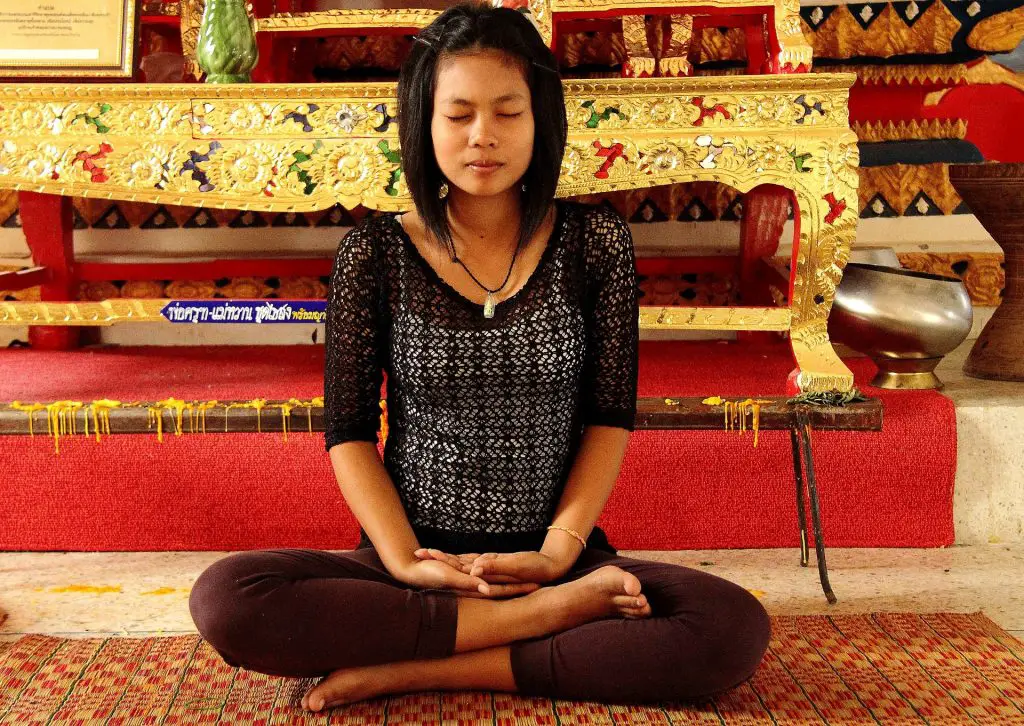Satipatthana Meditation, also known as the Four Foundations of Mindfulness, is a central practice in Buddha’s teachings. By engaging in this meditation style, you will delve into the nature of your body, feelings, mind, and mental qualities. This exploration aims to develop a wholesome state of mind and enhance your overall well-being.

As you begin practicing Satipatthana Meditation, you will focus on observing sensations and experiences related to the body, feelings, mind, and mental qualities. This observational approach allows you to cultivate mindfulness, enhancing your present-moment awareness and sharpening your attention. In time, this transformative practice can lead to greater clarity, reduced mental clutter, and a heightened sense of inner peace.
With continuous practice, Satipatthana Meditation can become an integral part of your daily routine, fostering a deeper connection with yourself and your experience of life. Through mindfulness, you can develop greater insight into your thoughts, emotions, and actions, ultimately empowering you to live a more fulfilling and harmonious life.
Origins and History
As you delve into Satipatthana Meditation, it’s important to look back at its origins and history. Rooted in the teachings of the Buddha, Satipatthana is the foundational instruction for cultivating mindfulness. It focuses on the four establishments or foundations of mindfulness: body, feeling-tone, mind, and dharmas.

Historically, Satipatthana has been closely tied to both samatha and vipassana meditation practices. According to Bhikkhu Sujato, in the early teachings, Satipatthana was primarily associated with samatha, which later evolved into vipassana. This transition highlights the interconnected nature of these practices, as they cannot be divided in the original Suttas.
The development of the Satipatthana Sutta itself saw some changes over time. In its earliest form, as argued by Bronkhorst (1985), the Sutta contained only the observation of impure body parts under mindfulness of the body. Over time, mindfulness of dhammas came to include the observation of the seven awakening factors. The Sutta is now widely regarded as the scriptural foundation for vipassana practice, particularly within the Theravāda tradition in South and Southeast Asia.
In learning about the origins of Satipatthana Meditation, you’ll find that the four satipaṭṭhānas are identified as the first four factors of the thirty-seven factors of enlightenment. This connection underscores the importance of Satipatthana as a cornerstone of mindfulness practice and its potential to bring about personal realization and awakening.
Four Foundations of Mindfulness

As you explore Satipatthana Meditation, it’s important to understand the Four Foundations of Mindfulness. These foundations serve as the core principles of this practice and will guide you towards a deeper connection with your mindfulness journey.
The first foundation of mindfulness is mindfulness of the body. By focusing on your body, you become aware of various sensations, postures, and breath. This helps you to develop a sense of presence and groundedness within your physical self. Start by paying attention to your breathing, then gradually expand your awareness to other aspects of your body such as movements, tension, and relaxation.
Next is mindfulness of feelings or sensations. In this foundation, you learn to observe your feelings and sensations objectively without becoming overwhelmed by them. Whether you experience pleasant, unpleasant, or neutral sensations, notice them without judgment and let them be. Recognizing these sensations allows you to better understand your emotions and manage them effectively.
The third foundation is mindfulness of the mind, which involves observing your thoughts and mental states. As thoughts and emotions arise, acknowledge them without identifying with them or getting caught up in their content. Practice nonjudgmental observation of your thoughts and maintain an open, accepting attitude towards them. This practice cultivates mental clarity and fosters a balanced perspective on your experiences.
Lastly, the fourth foundation is known as mindfulness of dharmas or mental objects. This goes beyond observing your thoughts and delves into the nature of phenomena and reality. By bringing awareness to various mental qualities such as the Five Aggregates of Clinging, the Six Sense Bases, and the Seven Factors of Awakening, you develop an understanding of the true nature of existence and cultivate wisdom and insight.
Remember, practicing these Four Foundations of Mindfulness consistently and patiently will strengthen your Satipatthana Meditation and lead you towards a deeper understanding of your mind and the world around you.
Benefits of Satipatthana Meditation

As you practice Satipatthana Meditation, you’ll start to notice several benefits that can positively impact your everyday life. The method of cultivating mindfulness through the four foundations can enhance your understanding of your body, feelings, mind, and dharmas. Here are some of the key benefits:
1. Improved Focus and Concentration: Satipatthana Meditation helps you train your mind to stay present, resulting in increased focus and concentration on tasks at hand. You’ll notice that you’re able to be more productive and efficient in both personal and professional situations.
2. Emotional Balance: By observing your feelings and emotions without judgment, you’ll learn to maintain emotional balance amidst various life situations. This can lead to a more fulfilling, harmonious, and stress-free lifestyle.
3. Enhanced Self-Awareness: Becoming more mindful of your thoughts, emotions, physical sensations, and reactions allows you to develop greater self-awareness. This higher level of self-understanding can lead to healthier decision making, better relationships, and an overall improved sense of well-being.
4. Reduced Stress and Anxiety: Through the practice of Satipatthana Meditation, you’ll learn to manage stress and anxiety more effectively. By observing sensations and reactions without judgment or attachment, you’ll develop the skills needed to cope with stressful events in a healthier manner.
5. Cultivating Positive Qualities: Over time, the practice of Satipatthana Meditation can support the cultivation of positive qualities such as compassion, loving-kindness, and equanimity. As you learn to understand the interconnectedness of all beings, your actions will become more aligned with these positive virtues, enhancing your overall well-being and happiness.
It’s important to approach your Satipatthana Meditation practice with patience, dedication, and consistency. As you grow more experienced, these benefits will become more pronounced, bringing balance, greater awareness, and overall improvement to your quality of life.
How to Practice
Practicing Satipatthana Meditation requires focusing on four main areas, also known as the Four Foundations of Mindfulness. These are mindfulness of the body, feelings, mind, and mental phenomena. Let’s break down the steps to help you practice effectively.

First, find a quiet and comfortable place to meditate. Sit in a comfortable position with your back straight, and close your eyes. You may choose to meditate on a cushion or chair if preferred. Start by bringing your attention to your breath. Observe the sensations of your inhales and exhales, and allow your awareness to settle on the natural rhythm of your breathing.
- Mindfulness of the body: Begin by scanning your body from head to toe, observing each part and any sensation you may encounter. Observe the various positions of your body, whether you’re sitting, standing or walking. Acknowledge the impermanence of these positions as they constantly change. Additionally, maintain awareness of the breathing process, as well as any other physical activities or postures.
- Mindfulness of feelings: Move your attention to the sensations and feelings that arise within your body. These can be pleasant, unpleasant, or neutral. Observe these feelings without judgment, simply recognizing them as they come and go. This practice cultivates an understanding of the impermanent and ever-changing nature of feelings.
- Mindfulness of mind: Shift your focus to your mind and mental states. Observe your thoughts, emotions, and mental formations as they arise, without becoming attached to them. Practice non-judgmental awareness, allowing thoughts and emotions to come and go without indulging in them or suppressing them.
- Mindfulness of mental phenomena: Lastly, focus on the various mental phenomena, such as mental objects or concepts, that arise during meditation. Observe how they are connected to the previously mentioned aspects (body, feelings, and mind). Recognize the impermanent nature of these phenomena and how they are influenced by and influence your mental and physical state.
Remember to maintain a gentle and non-judgmental attitude throughout your practice. Over time, your ability to stay present and mindful will improve, leading to a deeper understanding of yourself and the world around you.
Common Challenges and Tips in Satipatthana Meditation
As you practice Satipatthana Meditation, you may face some challenges. Here are a few of them, along with tips to overcome them:
1. Distracting thoughts: As a beginner, it’s normal for your mind to wander away from the object of focus during meditation. When you notice this happening, gently bring your mind back to the subject without being judgmental.
2. Restlessness and boredom: You may find your mind becoming restless or bored during the practice. To counteract this, try varying the duration or object of your meditation. This can help rekindle interest and maintain focus.
3. Physical discomfort: It is essential to choose a comfortable position to mitigate any physical discomfort during meditation. Experiment with various postures, cushions, or chairs to find what works best for you.
4. Maintaining consistency and motivation: Set aside a specific time each day for your practice and create a designated meditation space. This will help you establish a routine and make meditation a habit. You can also join a group or find a meditation partner to help maintain motivation.
5. Overcoming expectations and impatience: Avoid expecting quick results, as progress in meditation can be gradual. Maintain a balanced approach, and remember that the journey of mindfulness is as important as the goal.
Here is a guided Satipatthana Meditation:
Conclusion
Satipatthana Meditation is a foundational practice in Buddhism, aimed at developing mindfulness across various aspects of your life. By focusing on the four foundations – body, feelings, mind, and dharmas – you can cultivate deep self-awareness and foster personal growth.
As you progress in your Satipatthana Meditation practice, you will notice an increase in your ability to remain present in the moment, allowing a clearer understanding of your own thought processes and emotional states. This clarity can help you overcome common challenges in your meditation practice, such as the Five Hindrances, and lead you to a more profound sense of inner peace.
To further enhance your experience with Satipatthana Meditation, consider enrolling in online courses, guided workshops, or seeking guidance from experienced practitioners. These resources can help provide valuable insights and support as you commit to your practice.
Remember, mindfulness is a skill that requires consistent effort and dedication. Embrace the teachings of Satipatthana Meditation, and you will gradually discover the transformative effects on your well-being, personal growth, and understanding of the beautiful complexities of life.
